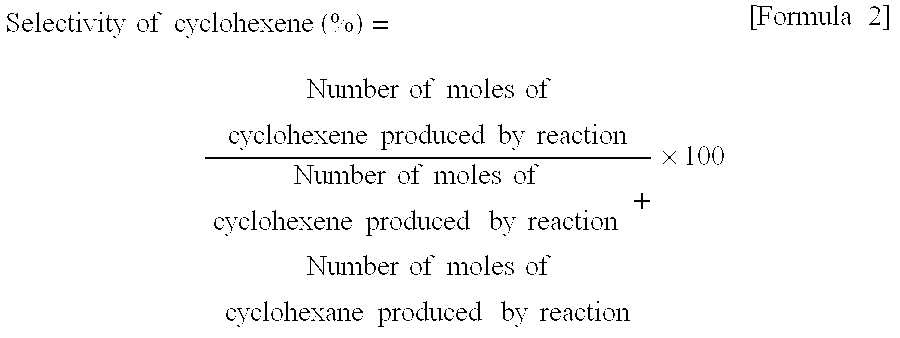Process for production of cycloolefin
a cycloolefin and process technology, applied in the direction of catalyst regeneration/reactivation, physical/chemical process catalysts, metal/metal-oxide/metal-hydroxide catalysts, etc., can solve the problems affecting the regeneration capability of the catalyst, and achieve the reduction of cycloolefin selectivity, high catalytic activity and cycloolefin selectivity after the catalyst is regenerated, and efficient production
- Summary
- Abstract
- Description
- Claims
- Application Information
AI Technical Summary
Benefits of technology
Problems solved by technology
Method used
Image
Examples
example 1
[0083]In 260 ml of distilled water, was dissolved 6.5 g of ruthenium chloride hydrate (containing 40% by weight of ruthenium). To the mixture, was added a solution prepared by dissolving 0.27 g of zinc chloride in 20 ml of distilled water. To the resulting mixture, was added 20 g of a zirconium oxide powder (manufactured by Wako Pure Chemical Industries, Ltd.) whose chloride ion content was 70 wt ppm, followed by stirring so as to obtain a uniform suspension. To the resulting suspension, was added over 1 hour an aqueous solution prepared by dissolving 28.0 g of sodium borohydride in 730 ml of distilled water, while maintaining the temperature of the suspension at 30° C. or lower and cooling the aqueous sodium borohydride solution with ice. After adding the whole amount of the aqueous sodium borohydride solution, the mixture was stirred at room temperature for 1 hour and then left at rest at room temperature for 16 hours. The resulting catalyst slurry was filtered and washed with dis...
example 2
[0090]As a ruthenium catalyst, was used 8 g in terms of dry weight of a ruthenium hydride catalyst containing 7% by weight of zinc obtained by reducing ruthenium hydroxide in which zinc hydroxide was previously contained. The content of chloride ions in the catalyst was reduced to 10 wt ppm or less by suspending the catalyst in an aqueous sodium hydroxide solution and stirring the resulting suspension, followed by washing the catalyst with distilled water. The catalyst had an average crystallite size of about 6.3 nm. The continuous partial hydrogenation of benzene was carried out in the same manner as in Example 1 except that 64 g of a zirconium oxide powder (manufactured by Wako Pure Chemical Industries, Ltd.) whose chloride ion content was 70 wt ppm was used as a dispersant.
[0091]The results of partial hydrogenation at 500 hours after the start of the reaction showed a benzene conversion of 41% and a cyclohexene selectivity of 78%. At this time point, a small amount of the catalys...
example 3
[0096]In 300 ml of distilled water, was dissolved 15 g of ruthenium chloride hydrate (containing 40% by weight of ruthenium). To the mixture, was added a solution prepared by dissolving 1.0 g of zinc chloride in 50 ml of distilled water. To the resulting mixture, was added 50 g of a zirconium oxide powder (manufactured by Wako Pure Chemical Industries, Ltd.) whose chloride ion content was 70 wt ppm, followed by stirring so as to obtain a uniform suspension. To the resulting suspension, was added 200 ml of a 1 N aqueous sodium hydroxide solution. After adding the whole amount of the 1 N aqueous sodium hydroxide solution, the mixture was stirred at room temperature for 1 hour and then left at rest at room temperature for 16 hours. The resulting catalyst (a mixture of ruthenium hydroxide, zinc hydroxide and zirconium oxide) was filtered and washed with distilled water until the filtrate had a neutral pH. Subsequently, the resulting catalyst was suspended again in 200 ml of a 1 N aqueou...
PUM
| Property | Measurement | Unit |
|---|---|---|
| Fraction | aaaaa | aaaaa |
| Time | aaaaa | aaaaa |
| Time | aaaaa | aaaaa |
Abstract
Description
Claims
Application Information
 Login to View More
Login to View More - R&D
- Intellectual Property
- Life Sciences
- Materials
- Tech Scout
- Unparalleled Data Quality
- Higher Quality Content
- 60% Fewer Hallucinations
Browse by: Latest US Patents, China's latest patents, Technical Efficacy Thesaurus, Application Domain, Technology Topic, Popular Technical Reports.
© 2025 PatSnap. All rights reserved.Legal|Privacy policy|Modern Slavery Act Transparency Statement|Sitemap|About US| Contact US: help@patsnap.com


